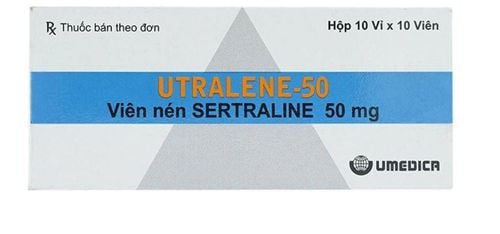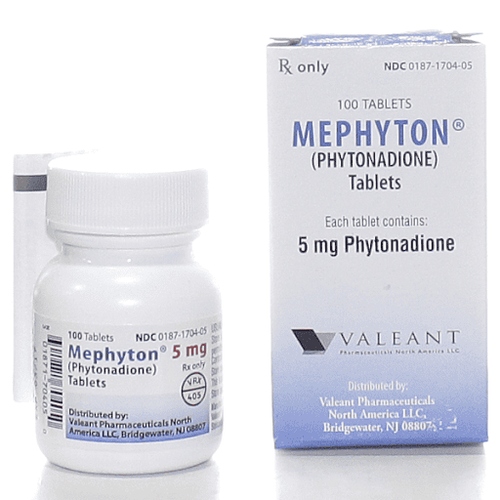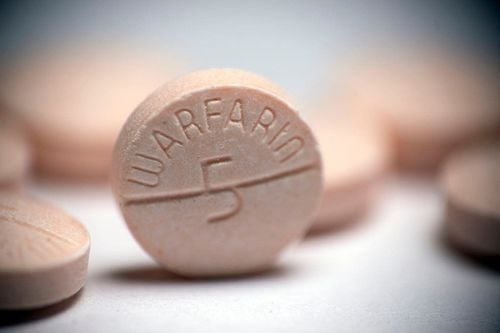This is an automatically translated article.
Azenmarol is a drug for treatment and prevention of thrombosis, indicated in cases of myocardial infarction, heart disease causing embolism, deep vein thrombosis,... Azenmarol has many notes and side effects, Therefore, patients should absolutely follow the doctor's instructions while using the drug.
1. What is Azenmarol?
Azenmarol is a drug belonging to the group of cardiovascular drugs. The main ingredient of the drug is Acenocoumarol. Azenmarol is prepared in 2 strengths: Acenocoumarol 1mg and 4mg. In addition, also in the form of tablets and packaged in blisters of 10 tablets.1.1 Pharmacodynamics of Azenmarol Acenocoumarol is a coumarin derivative with anti-vitamin K activity. These drugs inhibit vitamin K epoxide reductase enzyme, thereby preventing the conversion of glutamic acid to gamma-carboxyglutamic acid of other compounds. precursor proteins of clotting factors (II, VII, IX, X).
Therefore, vitamin K antagonist coumarin derivatives have indirect anticoagulant effects through the mechanism of preventing the synthesis of active forms of coagulation factors II, VII, IX, X above.
After oral administration of acenocoumarol, its effects are usually maximal within 24 to 48 hours with prolonged prothrombin time, depending on the dose. 48 hours after drug discontinuation, prothrombin returns to pre-dosing levels.
After being taken orally, vitamin K antagonist coumarin derivatives will cause hypoprothrombinemia for a period of 36 to 72 hours. Balancing vitamin K antagonist therapy takes several days. After discontinuation of the drug, the anticoagulant effect may persist for another 2 to 3 days. Although there is no direct thrombolytic effect because it does not reverse ischemic tissue damage, vitamin K-resistant coumarin derivatives may limit the development of pre-existing blood clots. and may prevent secondary thromboembolic symptoms.
Acenocoumarol has the advantage over warfarin and phenprocoumon in its shorter duration of action. Pharmacokinetics Azenmarol Acenocoumarol is fairly rapidly absorbed from the gastrointestinal tract. Oral bioavailability is 60%. Most of the S(-)-acenocoumarol isomer undergoes first-pass metabolism in the liver, while the bioavailability of the R(+)-acenocoumarol isomer is 100%. Acenocoumarol has a very high plasma protein binding rate (99%). Peak plasma concentrations are usually reached within 1-3 hours. The volume of distribution of the drug is 0.16 - 0.34 liters/kg.
Acenocoumarol can cross the placenta and small amounts have been detected in breast milk. Acenocoumarol is metabolized in the liver to inactive amine and acetamide metabolites by the cytochrome P450 enzyme system. Several other metabolites such as diastereoisometric alcohol and the hydroxyl metabolite may also be active. Clinicians should be aware of the possibility that some patients are highly susceptible to acenocoumarol due to hepatic mitochondrial polymorphism, in whom dose reduction may be necessary.
The half-life of acenocoumarol is about 8-11 hours. Acenocoumarol is eliminated mainly in the urine in the form of metabolites and partly in the feces.
2. What are the uses of Azenmarol?
The drug Azenmarol works to prevent blood clots. Therefore, the drug is often indicated in the treatment of the following cases:Heart disease causing embolism: Prevention of thromboembolic complications caused by atrial fibrillation, prosthetic valve, mitral valve disease. Myocardial infarction: Prophylaxis of thromboembolic complications in myocardial infarction, complications such as thrombosis on the heart wall, left ventricular dysrhythmia causing embolism when receiving heparin replacement therapy, dysfunction severe left ventricle. Prophylaxis in the treatment of recurrent myocardial infarction when aspirin cannot be used. Treatment of patients with deep vein thrombosis and pulmonary embolism. Prophylaxis of recurrence as an alternative to heparin therapy. Prophylaxis in patients with venous thrombosis, pulmonary embolism during hip surgery. Prophylaxis when the patient has a thrombus in the catheter.
3. Dosage and how to use Azenmarol?
The dose of the drug must be adjusted to achieve the goal of preventing the coagulation mechanism to the extent that no thrombosis occurs but to avoid causing spontaneous bleeding. Depending on the treatment response of each patient, the doctor will prescribe the appropriate dose.
3.1 Usual oral dose The first day take a dose of 4mg / day, the second day take a dose of 4 - 8 mg / day.
Maintenance dose of the drug is from 1 to 8 mg/day, depending on biological response.
Dose adjustments are usually made in increments of 1 mg.
3.2 Biological monitoring and dose correction A suitable biological test is the measurement of prothrombin time (PT) expressed as the International Normalized Ratio (INR). Through prothrombin time to probe factors II, VII, X, which are reduced by vitamin K antagonists. Factor IX is also decreased by vitamin K antagonists, however prothrombin time is not used to probe. .
If vitamin K antagonists are not used, the INR in normal people is 1. When using drugs in most cases, the target INR needs to be 2.5, fluctuating between 2 and 3. In case INR below 2 reflects the Anticoagulants are not enough. An INR above 3 is an overdose. An INR above 5 is a risk factor for bleeding.
3.3 How to take Azenmarol Azenmarol should be taken once at the same time each day.
3.4 When using Azenmarol drug overdose, what should we do? The most common manifestation of Azenmarol overdose is bleeding, which can occur within 1-5 days of taking the drug. Hemorrhagic symptoms may be noticed: nosebleeds, vomiting blood, hemoptysis, gastrointestinal bleeding, hematuria (with renal colic), subcutaneous hemorrhage, vaginal bleeding , bleeding gums, hematomas, and bleeding in joints or menorrhagia.
There may be symptoms of tachycardia, hypotension, peripheral circulatory disorders due to blood loss, nausea, vomiting, diarrhea, abdominal pain.
For cases of Azenmarol overdose, usually the doctor will base on the INR and bleeding signs to conduct sequential adjustment measures to avoid the risk of thrombosis. If anticoagulants have been taken but not vitamin K, the INR should be retested in 2-3 days to ensure that the INR has decreased.
In case of accidental poisoning, must also assess the level of danger according to INR and bleeding complications. INR should be measured 2 - 5 days later. Use of vitamin K to correct the effects of the anticoagulant azenmarol.
4. Contraindications in treatment with Azenmarol
Some contraindications in treatment with Azenmarol can be mentioned as:
People with a history of hypersensitivity to coumarin derivatives or to any component of Azenmarol. People with vitamin C deficiency, bacterial endocarditis, blood dysplasia or any blood disorder have an increased risk of bleeding. Patients with severe hypertension. Patients with severe hepatic impairment, especially when prothrombin time has been prolonged. People who are at risk of bleeding, have recently undergone neurosurgery and eye surgery or are likely to have to have surgery again. Patients with cerebrovascular accident, except those with thrombosis elsewhere. People with severe renal impairment (Clcr < 20 mL/min). Esophageal varices. People suffering from peptic ulcers. Should not be combined with high-dose aspirin, phenylbutazol, chloramphenicol, diflunisal, pyrazole non-steroidal anti-inflammatory drugs, miconazole for systemic and vaginal administration. Do not take azenmarol within 48 hours of giving birth.
5. Drugs that interact with azenmarol
Many drugs can interact with vitamin K antagonists, so it is necessary to monitor the patient for 3-4 days after changing the combination drug. Azenmarol should not be used in combination with the following drugs:
Aspirin, especially at high doses of 3g/day, because it increases the anticoagulant effect and the risk of bleeding by inhibiting platelet aggregation and causing separation of the anticoagulant. from binding to plasma proteins. Miconazole: Severe bleeding may occur due to increased free form in the blood and inhibition of metabolism of vitamin K antagonists. Phenylbutazone, because of increased anticoagulant effect if combined. Non-steroidal anti-inflammatory drugs of the pyrazol group: Increased risk of bleeding due to platelet inhibition. Azenmarol should not be combined with the following drugs:
Aspirin with a dose of less than 3g/day. Non-steroidal anti-inflammatory drugs. Chloramphenicol: Increases the effect of oral anticoagulants if combined by reducing this drug's metabolism in the liver. Diflunisal: Increased anticoagulant effect, due to competition for binding to plasma proteins. It is recommended to take another pain reliever such as paracetamol.
6. Adverse Effects (ADRs)
Manifestations of bleeding are the most common complications, can occur in all parts of the body: central nervous system, extremities, abdominal cavity, viscera, eyeballs,... In some cases, diarrhea may be accompanied by fatty stools, joint pain alone. Rare: Alopecia, focal skin necrosis, allergic skin rash. Very rare: vasculitis or liver damage. Above is important information about the drug Azenmarol. You need to read the instructions carefully to have a safe way to use the medicine.
Please dial HOTLINE for more information or register for an appointment HERE. Download MyVinmec app to make appointments faster and to manage your bookings easily.













